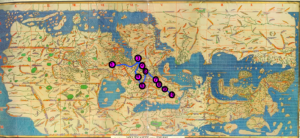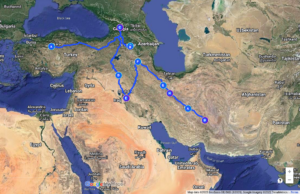
Page 7 of 39

Felix Fabri spends barely a day at Mt. Carmel. During his time there, he primarily recants the many biblical stories that make the mountain a holy and important site. Fabri also speaks somewhat of the land around the mountain. Fabri speaks of how the land of Carmel is the origin place of the Carmelite Friars as well as the location where the biblical prophet Elias killed the prophets of Baal according to 1 Kings in chapter eighteen. He also mentions the location of the burial sites of the Maccabee people and the brook of Kishon at the foot of the mountain. Fabri also makes brief mention of the relationship between the religious figures in the area in relation to the memory of Elias and the other biblical figures in the area. He also speaks how a man named Albert who was patriarch of Jerusalem when “Latin Christians held Siria” had friars wear copes with gray horizontal strips in homage to Elias. Fabri speaks of how this was the case up until Pope Honorius III changed the stripped cope to an all-white one due to the fact that it could not be proven whether or not Elias wore a grey stripped cope specifically. While this is unique in comparison to men like Marco Polo, it is not unique in comparison to other devote religious individuals. While Fabri’s recount of this specific area of the world is very short, it does give us a lot of background information on the significance of this area of the world, especially to anyone who is a devoted Catholic. While most of Fabri’s recounts are very clearly written for people who would already would have spent most of their time studying the bible, for instance a friar or priest, this specific account seems to have been written for anyone in comparison. I claim this primarily because, in this section, Fabri goes into detail about the history, biblical and religious, of this region of the world without any religious jargon aside from the word cope. He speaks of the beauty of the land and the history in a way that comes across as something he would recount to a religious congregation rather than something he would tell his other friar friends.
The Book of Margery Kempe
Location: Her Soul’s Destination
Kempe claims that her relationship with God had reached a level where it merited official recognition and celebration. This wedding, to God, happened somewhere in her spiritual being and Kempe signifies that the love shared between Goof and her had moved to a greater destination (Kempe 175-176). Kempe. Kempe describes the people who came to bear witness to her relationship with God, including Mary, Jesus, many saintly virgins, and each of the apostles (Kempe 175-176). They all show their support for Kempe with their praying for the future of her relationship with God (Kempe 176). Kempe chooses to also give us a glimpse into her emotions when she talks about being awestruck and shy when conversing with God (Kempe 175). Kempe records that changes to her relationship with God caused changes to her senses. Kempe began to smell something so perfectly sweet that it was unrecognizable to her. She seems to have been incredibly impressed by this sensation as it was pleasant enough for her to want it frequently (Kempe 176) She also began to her hear music and noises that affected her ability to communicate with other people as it distracted her; Kempe states that she was more likely to experience the noise when she was currently in the process of worshipping. Kempe also joyfully received these sensations of sounds as joyfully as the delicious smell and claimed that both of them had a beneficial affect on her body (Kempe 176-177) Another of the fantastical things she experiences are displays of beautiful light (Kempe 177). These sensations may show Kempe starting to understand what the afterlife is like; this is because she finds herself pleased with smells that don’t belong to earth and having her hearing other people impeded by something which she attributes to God (Kempe 178). In this way, she may be saying that she is already experiencing heaven while still alive. (Kempe 176-177)
I find the fact that Kempe states Christ views her as both like a wife and a mother figure to be something that probably made more sense during Kempe’s lifetime. This is essentially true as Kempe articulates that God married her but wanted her relationship with him to have aspects that are described as a mother and child form of relationship (Kempe 175,175-179) I also cannot understand how Kempe describes God’s stronger love for her than most of his other followers, and expects readers to just believe her without offering them any solid proof(Kempe 175-179)I believe that it is possible Kempe’s description of Jesus calling her to treat him like a son and a husband is possibly due to common people in her culture not having the vocabulary to talk about love as thoroughly as they wanted to (Kempe 175-179) This could also be a result of a tendency to associate different types of actions displaying love with different relationships. I believe that Kempe may have written about this change in her relationship with God in order to gain attention. This is because it is so different room anything that I have ever heard of someone claim that it seems like she is so desperate for people to people her that she has made up this encounter to be as outlandish as possible. (Kempe 175-179)
Margery Kempe, The Book of Margery Kempe, chapter 35, translated by BA Windeatt, 1985.https://www.ebooks.com/en-us/book/210517733/the-book-of-margery-kempe/margery-kempe/
In the final section of his travel narrative, Felix Fabri describes his departure from Joppa and The Holy Land, and he disproves the many false narratives that surround the retelling of the journey. For example, he mentions the myth that the Saracens forced him along with the other pilgrims to ride upon the backs of donkeys (or “asses”) while traveling again to The Holy Land because they presumed that they were too unholy to walk upon the land barefoot. He claims that the Saracens did not care whether he or the pilgrims walked or traveled on horseback during their departure from The Holy Land. He then describes the twenty-seven articles that the Father Guardian, their religious leader during the pilgrimage, preached to them upon their return to Mount Zion. These articles instructed the proper behavior of the pilgrims during their time in The Holy Land, kind of like the rules that tourists are given during their visits to a museum or a zoo, but much more religiously focused.
The nature of these articles is particularly interesting because they all serve as guidelines for the Christian pilgrims to respect themselves, the Saracens’ religion, and the physical space around them. This is very different from the behaviors of white Christians who have traveled to other parts of the world at different points in history, which often resulted in the major disruption of the cultural and religious practices that existed prior to their arrival. Article twenty-three in particular is very keen on the potential disrespect that the pilgrims could potentially demonstrate to the religious practices of the Saracens that reside in the Holy Land. I think in some ways, these articles seem more modern, as they acknowledge every interaction that may occur between the white Christians and the Saracens, and they condemn any form of condescension that may come from the Christians’ end.